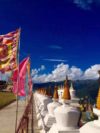
Sightseeing In the Area
Maerkang, which in Tibetan means “The Place Lightened by Butter Lamps,” is not the most tourist-friendly place to visit as almost no one speaks English and it can be difficult to find a way to travel to and from here. Many places will not rent rooms or offer a place to sleep to foreigners, although you may get lucky and find a local who is willing to help. Despite all this, there are still plenty of sites to see in the area. The Dazang Temple is a popular destination, with a wonderful view of the ancient block houses below and beautiful views of the snowcapped mountains and plant life in the area. Near the towns of Songgang and Shaerzong, both are nice places to stop for a bite to eat and take in more historical sites.
The Maerkang Temple
Located on Zangkou Mountain, the Maerkang Temple is another popular destination for visitors. Not only does this temple offer a look at a historic site, but from the mountainside, views of the valley below are plentiful. From the base of Zangkou Mountain, the Suomo River Canyon flows all the way to the Baiwan Township.

A Chance to View History
Not far from Maerkang, roughly ten minutes away, is the village of Zhoukeji. Here you can see the renovated watchtower fortress, which was formerly occupied by Mao Zedong. He stayed here several times during the Long March. For a steep price you can gain entry and also have another view of the surrounding landscape. Across from the watchtower is a small village featuring many traditional Tibetan architectural structures.
Take In The Scenic Beauty
Some of the best scenic locations in the area are only a short distance away from Maerkang, in Miyaluo, which some describe as almost like a fairy tale in autumn. Mostly overgrown vegetation, clear water from the mountains, vast plant and animal life, and the red leaves that cover the area that time of year offer an abundance of photo opportunities. Complete with flowing rivers and waterfalls, giant maple trees and even bubbling hot springs, the area is great for anyone looking for solace or inspiration.
Events for Visitors
During certain times of the year, the area is also host to a number of festivals and events including new years and many horse racing events complete with barley wine, music and plenty of traditional food.












